Poland’s annual pilgrimage to Czestochowa is one of the biggest religious gatherings in Europe. Every August, tens of thousands of the faithful assemble in hundreds-strong groups and travel on foot like a holy army, many for over a week, singing songs, praying, attending two services a day, to pay their respects to a mysterious Black Madonna, their national shrine. But is it a place for tourists?
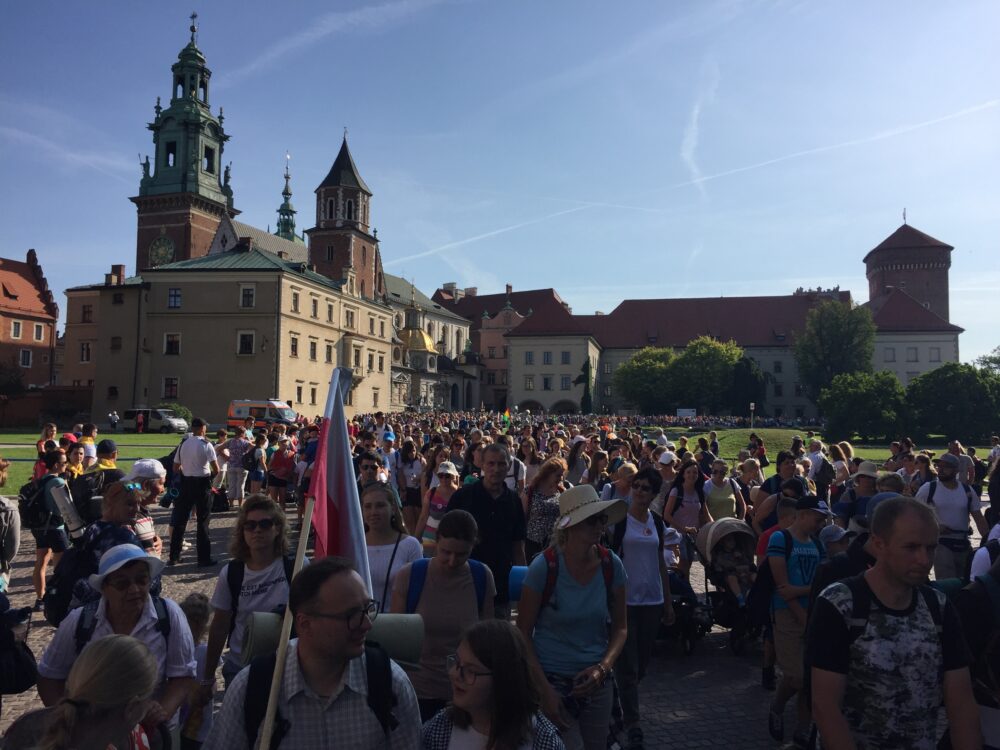
Pilgrims leave Wawel Castle (Photo: Chris Newens)
I’ve walked two hours from Krakow’s centre before the four hundred Franciscans I am with realise I am wearing them as a disguise.
We are a holy army, happy-clapping through suburbs, clogging arterial roads, cheered forward at every street corner; even the traffic-jammed commuters are pleased to see us. The snarl we’ve created offers them a chance for penance, too – Give me ten Hail Marys, and four hours in tailbacks.
For this is Poland’s national pilgrimage. I am one among more than a hundred thousand people who have gathered from all over the country to join groups just like this one, to walk to a town called Czestochowa, where a portrait of a dark-skinned Virgin Mary – a Black Madonna – awaits their devotion.
This icon has hung at the heart of Polish Catholicism and national identity ever since it was credited for an impossible victory against an invasion by Protestant Sweden back in the early 18th Century. It is an Orthodox-style image of the Virgin, which legend holds was painted by Saint Luke himself; the dark hue of its skin is, even today, a mystery.
The painting captured my imagination, and I came to Poland to join the annual pilgrimage as a tourist. I even decided to join a group making the six day trek from Krakow because I thought I could get some sight-seeing done at the same time. Signing up was relatively simple and welcoming. Just a little Googling in Polish with the help of a translation app, then the trendy young volunteers who took my 35 euros in a Krakow youth centre to pay all my accommodation and food for the coming week seemed normal enough. Even if the price – because this pilgrimage sponsored by the church and run almost entirely by Christian charity – was miraculously low.
But since the grand, beautiful mass at Wawel Castle that morning – egg-shell blue dawn, congregation of thousands, silences so pure I could hear the incense rattle as it swung – I have been on edge. I have never seen such devotion on this scale before. This is no Camino, and I am unsure if I belong.
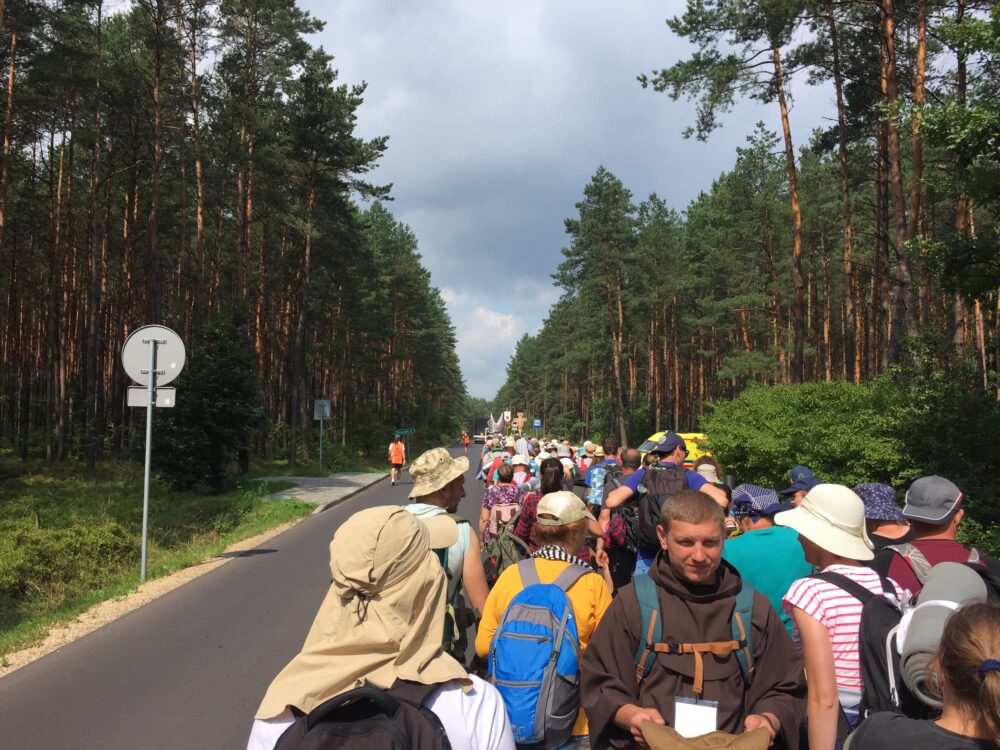
Pilgrims on the march. (Photo: Chris Newens)
“Can our friend from London come to the front?” the announcement crackles in English over our mobile sound system – three separate amplifiers, carried on the backs of the particularly pious, and linked by a wire, which also serves to cordon the crowd. I freeze (though, technically, because of the hundred-odd people still pushing behind me, I also keep walking). The “friend from London” is me.
I shoulder up passed lively teenagers, buggy pushing families, and wrought iron geriatrics, until I come to a moon-faced nun, clutching a mic.
She introduces me as “Our very special guest”, and tells everyone that she would be delighted if I could recite them some prayers in English. How’d I feel about doing a Chaplet of the Divine Mercy? I’ve never heard of this, and it does not sound like something I can bluff.
“I’m sorry,” I mumble into the proffered mic, “I’m” – Atheist? Agnostic? Only here for the beer? – “Anglican.”
A heartbeat of silence, but then the nun laughs and says sorry with such conviction I feel exonerated from all my sins. Except, I realise this whole exchange has taken place over the speaker system. Everyone here has heard my confession.
We loose ourselves of Krakow’s outskirts, enter a pleasant, if unremarkable landscape of rolling farmland. The most interesting thing about it all is us. We’re like some great slow-moving vehicle, occupying an entire lane of whatever road we’re walking: are a kaleidoscope of hiking clothes, threaded by skipping monks and nuns. When someone does at last start talking to me, it is not the conversation I expect.
“My mother told me I should walk to Czestochowa because it is a good way of finding a husband.”
The speaker’s name is Natalya, she is in her early thirties, and has a kind smile, which stretches broad under sad eyes.
“It is not unusual,” she continues. “Many of my friends find husbands on the way to the Black Madonna.”
I’m taken aback by what seem almost profane motives, but they also put me at ease. For all its religiosity, there’s a more relatable side to the Czestochowa pilgrimage. And as Natalya and I continue to talk about her work as an English teacher near Lublin (groups walk from there, too, but it’s too far for her) I start to notice how well dressed the teenage pilgrims are for hiking, particularly the girls. Many are in summer frocks and they are made-up as they might be for an evening out.
“It makes sense,” Natalya says to me. “A lot are away from their parents, away from the boys they grew up with.”
“So, is this the first time you’ve done the pilgrimage, then?” I ask, then cringe. After what we’ve been talking about, this is hardly a polite question.
After several more steps, Natalya responds.
“No,” she says, “my tenth.”
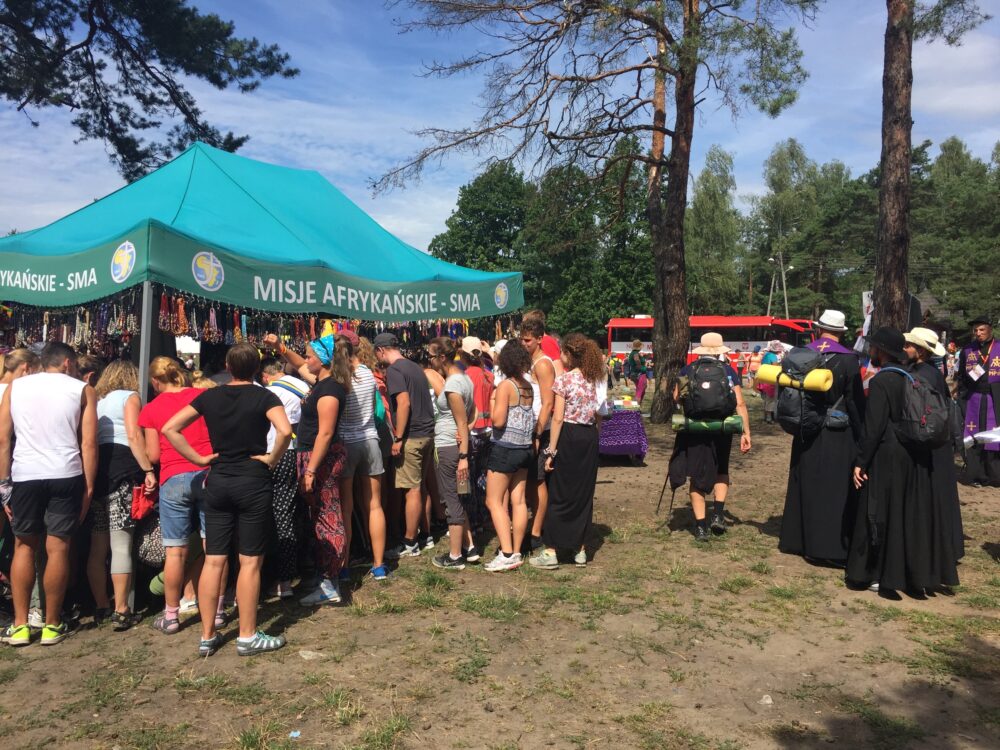
Market stand en route. It’s not only about religion (Photo: Chris Newens)
The stop that first night is at a cluster of houses round a cross-roads which we utterly overrun. Municipal buildings, gardens, and garages become free pilgrim accommodation; locals offering their property for the good of the country. I am directed to pitch my tent in the garden of an old farmer, which I am sharing with a wiry pilgrim called Piotr and his ten year-old son.
“We live in Czestochowa,” Piotr says as we share pickled cucumber. “But I am doing this pilgrimage with my son, so he understands why our town is important.”
We lapse into silence, exhausted after the exhausting day – we have walked almost twenty miles. For a few beautiful seconds there is nothing to hear but the croak of the countryside, or more distracting to look at than the evening sun as it purples behind western clouds.
“Are you going to the concert?” Piotr asks me.
The priest leading the Franciscans moonlights as a rock star. He is a gym-bodied six-two, fizzes with charisma, and has somehow styled his cassock like a hoody. And tonight, for one night only in this half-horse hamlet, he’s putting on a show.
Shattered as I am, I join the excited crowds as they mass through the gathering twilight out of town to the local church. I can hear bass pulsing through its neo-Gothic walls.
Inside, everything is illuminated by flashing fuchsia and white: the wooden pews, the oil paintings of Biblical scenes, Jesus in agony on his cross. It is also crammed with old people, teenagers, kids; there’s barely space to stand, there certainly isn’t space to dance, but that doesn’t mean people aren’t trying, thrusting, jiving, arms stretched upward to catch the glory of God. In front of the alter, the priest is rapping in Polish, to a reggae beat.
The next day begins way before dawn. Pilgrims sag weary around the support truck, like maybe they overdid it on the Holy Spirit last night. Still, many of the young girls have accomplished a costume change: fresh summer dresses spangle the crowds. I spy Natalya, who has changed too. She waves at me, but does not approach.
Our pre-breakfast walk is down rutted tracks into Ojców National Park, a space of lush foliage, dark green in the early light, and punctuated by exclamations of limestone cliff. We even take a break from singing.
“So we don’t wake the bats,” I am told by the moon-faced nun. I can’t tell if she is joking.
For mass, which I learn will happen every morning, we unite with the fourteen other groups walking the Krakow route. Pausing in a gully framed by two narrowly facing limestone cliffs, a natural structure known as the Gate of Krakow. It is already swarming with hundreds of the faithful. I have started to get the feeling that the pilgrimage is a great act of bible-inspired cosplay. It’s hardly surprising; Catholicism being the greatest work of fan fiction ever created.
The sermon, delivered in front of a make-shift alter, echoes with pagan intensity from the gully walls. Despite how awkward it is, every pilgrim still goes through the standing, sitting, and kneeling – motions as important to mass as the words themselves. Hymns are sung to an acoustic guitar, which makes them sound corny and out of place in this magnificent setting.
After mass, I am found a translator. His name is Lucas, a novice priest with cropped blond hair and silver eyes. He is smart and helpful, with a remarkable sense of duty for a 23 year-old. He becomes my very own Vatican II, demystifying the Polish liturgy, and bringing me up to speed with a controversy that is talk of the pilgrimage.
Before we set off, the Archbishop of Krakow made a public-address denouncing “LGBT ideology” as a “gay rainbow plague”. It is the latest salvo in what has become a theme of Polish Catholicism in recent years: the LGBT movement being talked up as a foreign ideology, in the same way that John-Paul II did with communism in the past. Now, Lucas tells me, many priests are rallying to defend the archbishop’s position. There is a feeling that the Catholic church is under attack.
“But do you agree with them, Lucas?” I ask, trusting on his youth and decency. “About the ‘rainbow plague’?”
“It’s, um, complicated,” the novice priest sucks his teeth. “We’re not talking about LGBT people, but their ideology.”
“I don’t see the difference.”
“It’s complicated. Jesus says love the sinner, hate the sin,” Lucas closes his eyes. “Sometimes, I think, the archbishop uses old fashioned language,” he concedes. “But it’s complicated theology. My English is not good enough to explain.”
I can’t get more from him than that.
Later, though, just as we are leaving Ojców, it rains, and the entire pilgrimage shawls itself in a rainbow of ponchos. We look like a congregation of monks at Pride.
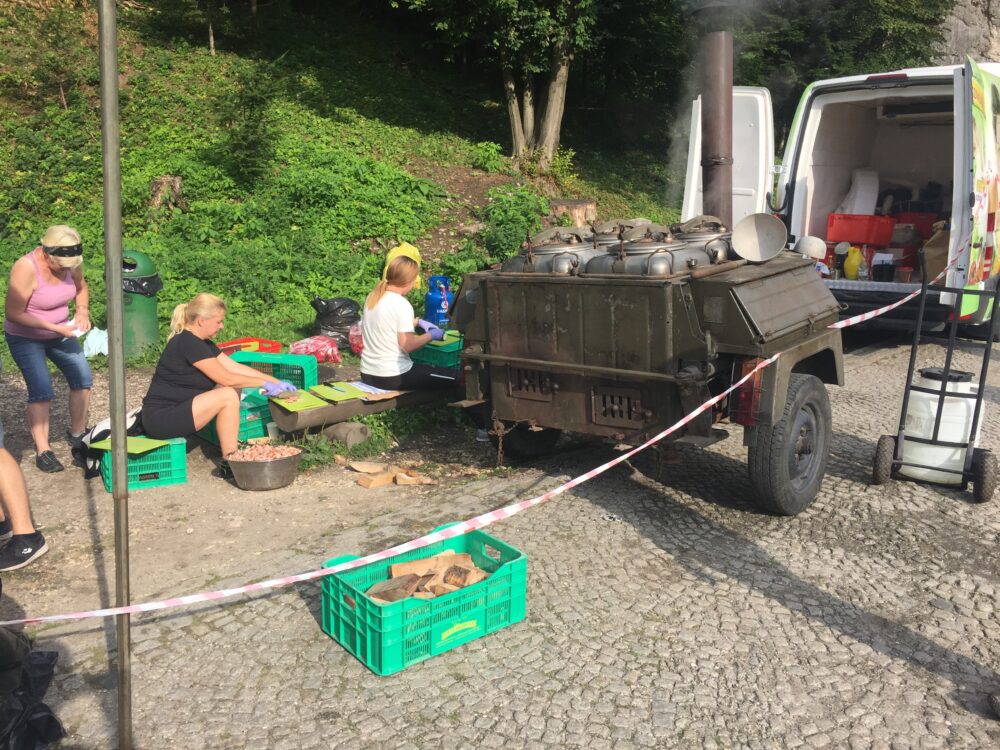
A war relic for brewing tea for the pilgrims. (Photo: Chris Newens)
The second night, I am billeted in a half-finished farmer’s house with three very different men. The rain outside has grumbled into a storm. In concrete rooms we take turns to wash off the day’s hike with cold water that coughs from rusty taps.
The farmer, retired now, and taciturn with nicotine fingers, serves us potatoes in yeast and dill broth, then leaves us under buzzing lights. We are too weary for anything that is not silence or intimacy, and settle on the latter. We talk about women. Not in a bloke-ish men together way, but with vulnerability; about our wives and love. We talk about the hardships of having children; two of the men have a six a piece. We talk about why we are walking the pilgrimage.
Greg, a stocky business owner, speaks first. All day, I have seen him carry kids on his shoulders, hang back to help the elderly, volunteer for the sound system. His pilgrimage is straightforward worship, he says, currying favour for his family, for Poland, for himself; bean-counting on God’s grace.
Next, speaks Rafael, a gangly civil servant with big brown eyes and a goofy smile. His pilgrimage is spiritual, a meditation through which he is trying to feel closer to God. The Black Madonna is a mediator, conduit to the Big Guy. He laments how many in Poland see her as the deity.
The third man, Kuba, younger, blond, quiet, professes a doubter’s faith: “I wish I had you guys’ experience with God. I believe, but I’m unsure. God is something I am always looking for. I’m here to help with that.”
I am so drawn in by all this, I do not realise it’s my turn.
I don’t believe, I admit. Not at all. I say I’m walking because I am curious, that maybe my walk will lead me to an understanding of what God means for others. This is as unimpeachable as I can make my motives. But the men are silent, staring awkward into their empty bowls. They know I am going to hell. The storm roars like a boiling kettle on the roof.
“At least you won’t end up with six kids!” Rafael says at last, and our laughter matches the rain.
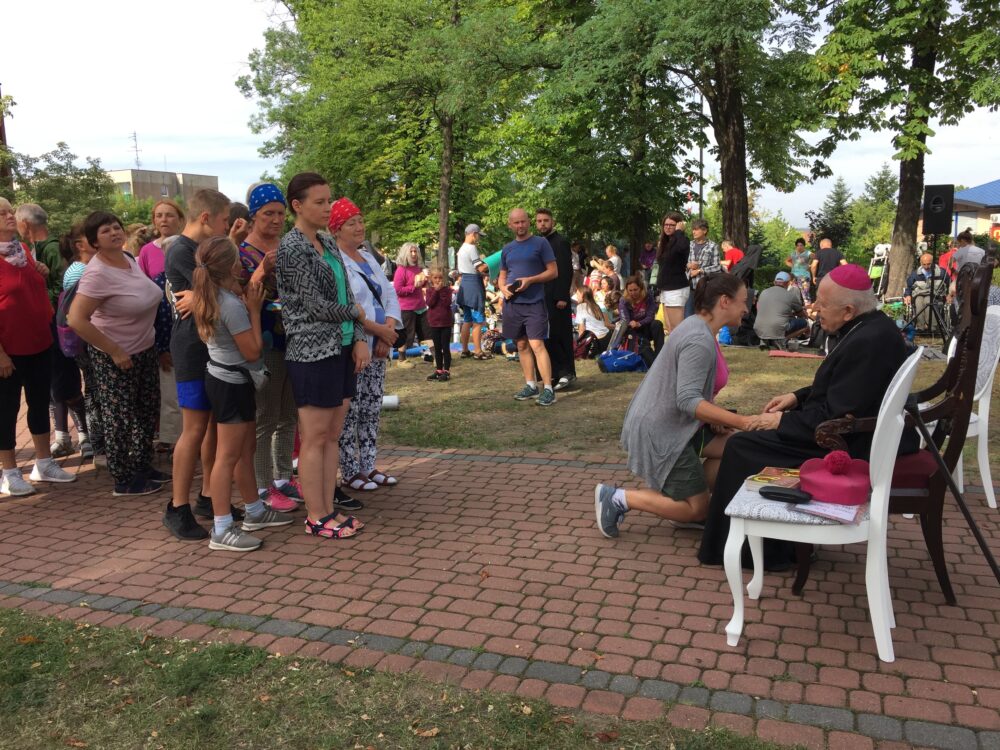
A bishop gives blessings. (Photo: Chris Newens)
Days blur. Early rises, mass, singing, afternoon sermon, prayer, sleep. And, of course, walking, all the time walking; fifteen, twenty, twenty-five miles a day. After Ojców the landscape sinks again into rural monotony, we walk long, straight, tarmacked roads, flanked by large modern houses and fields or by pine forest. Mostly, it’s pine forest.
Roads stretch like canyons through the trees and up ahead looks something like a motivational poster, just not motivational. I find some alleviation in the homemade shrines and crosses that pock the verges – symbolic of the smaller, folk side of Polish religion – and from time to time, our cavalcade veers onto smaller paths, into the forest itself, where older pilgrims dart from the line to gather wild blueberries growing on the floor.
The noise from the speakers is constant. The same ten or so songs are recycled over and over. Then, there is the daily rosary, delivered sombrely and in full; and at a certain point, priests read out “intentions”. These are the prayers of individual pilgrims, collected earlier by nuns, usually asking God for some personal favour or reprieve.
I’m talking to people casually, now. We may not share a religion, but we are sharing hardship, and that is what seems to count.
“The intentions are so boring,” confesses Veronica, a seventeen year-old who is walking with her cousin. “It’s only old people who put them in. They are not for the young.”
As though there’s nothing that young people want.
For the last two nights, we are billeted en masse in local high schools. Hundreds bed down on the scuffed wooden floors of gymnasia, and anywhere else they can find space. Walking down the corridors, I’m put in mind of buildings requisitioned after a natural disaster. Forced together like this, the most basic human needs develop a physical presence: the toilet queues are interminable, every power socket an anemone of charging cords, and the overworked communal showers only run cold. After the lights are killed at 9 the snoring is a symphony.
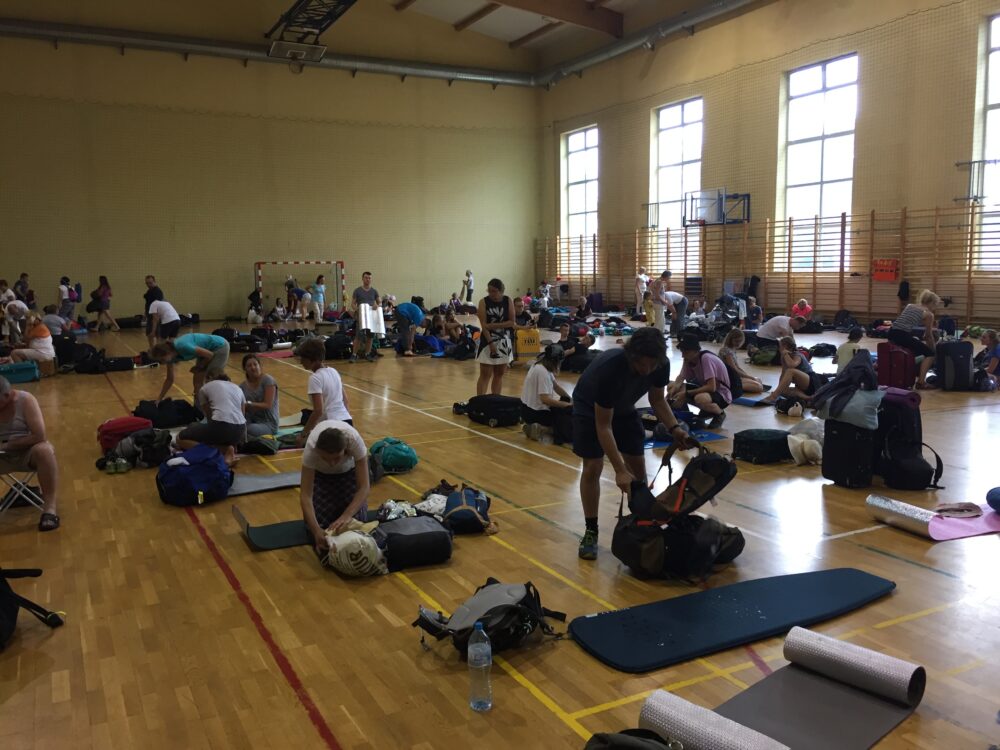
Bedding down in a school gymnasium. (Photo: Chris Newens)
The final day starts early, even in contrast to the others. We have walked two hours before the August sun crests the horizon. We must be close to Czestochowa, but the landscape is still rural. Banks of fog hang over the fields, and pilgrims wander to gather the wild flowers that bloom in abundant tasteful variety either side of the road.
“It’s to give as an offering to the Madonna,” Natalya tells me, like we are all on our way to see an ailing granny. Too late, I begin to gather my own pathetic bunch.
By 8am, we arrive at meadowed hill. Crowned by a cross, with slopes thronged by thousands. In the dawn’s golden light, it is a mount crying out for a sermon.
This is the Hill of Forgiving, Lucas explains, where, before entering Czestochowa, you are meant to ask your fellow travellers for forgiveness. Accordingly, after a short sermon, the hillside is swept by an orgy of hugging. I hug Lucas, hug Greg, hug Kuba, hug Rafael. I ask for forgiveness for coming on this pilgrimage as a non-Catholic, for wearing them like a disguise. Each says there is nothing to forgive.
I am sought out by Natalya. She has woven me a crown from the wild flowers she picked. But no sooner has she handed it over, than she looks embarrassed, waves away my gratitude, and slips into the crowds. I don’t see her again.
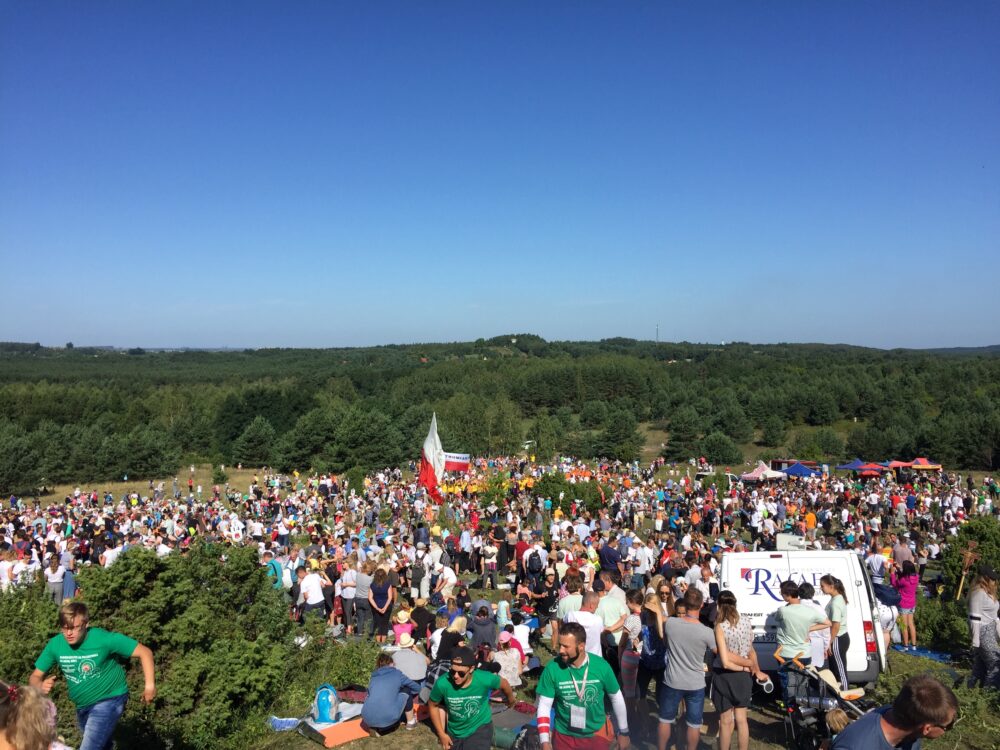
The crowds at the Hill of Forgiving (Photo: Chris Newens)
Nothing prepares me for Czestochowa’s main strip. From the Hill of Forgiving until now, the city has been just industrial sprawl. But tuning a corner into its main boulevard, it is Isengard. Jasna Gora monastery rises needle-like a mile ahead, and the whole wide road heaves with groups like ourselves.
This last stretch is hardest of the whole six days. We’re not on a pilgrimage now, we’re in a queue. Shuffling. The closer we get, the louder the honking of our music becomes, as though trying to party ourselves awake. Red and white balloons – the colours of the Polish flag – are distributed, we wave them in their thousands. Agonisingly we edge forward. The monastery looms. Until, suddenly, we’re in its grounds. We’re in space; there is breeze and there is light. It’s a vision of heaven, and we walk in freedom to the monastery entrance.
I am in the chapel of the Black Madonna.
The space is packed tight as pages in a Bible, with walls hung with redundant crutches and prosthetic limbs – the collateral damage of miracles past. I am mangled slowly to the front, toward the painting. Thousands are pushing at my back. It’s performative, but still: I fall to my knees.
Then I look at her.
I am struck by the Madonna’s unknowability. Her expression is so ancient that it has no meaning to modern eyes. Not to mine, at least. But she is beautiful, blankly beautiful, and she draws me in.
I don’t know quite how I expect to feel. She is not my god after all, but then, I realise, she is not a god for the pilgrims either. She is a conduit, a destination, an excuse. Trite as it is to say, Poland’s national pilgrimage is as much about the journey as the destination. It is the praying, the hardship, the friendships and the relationships forged along the way. And that is something we can all share, regardless of creed.
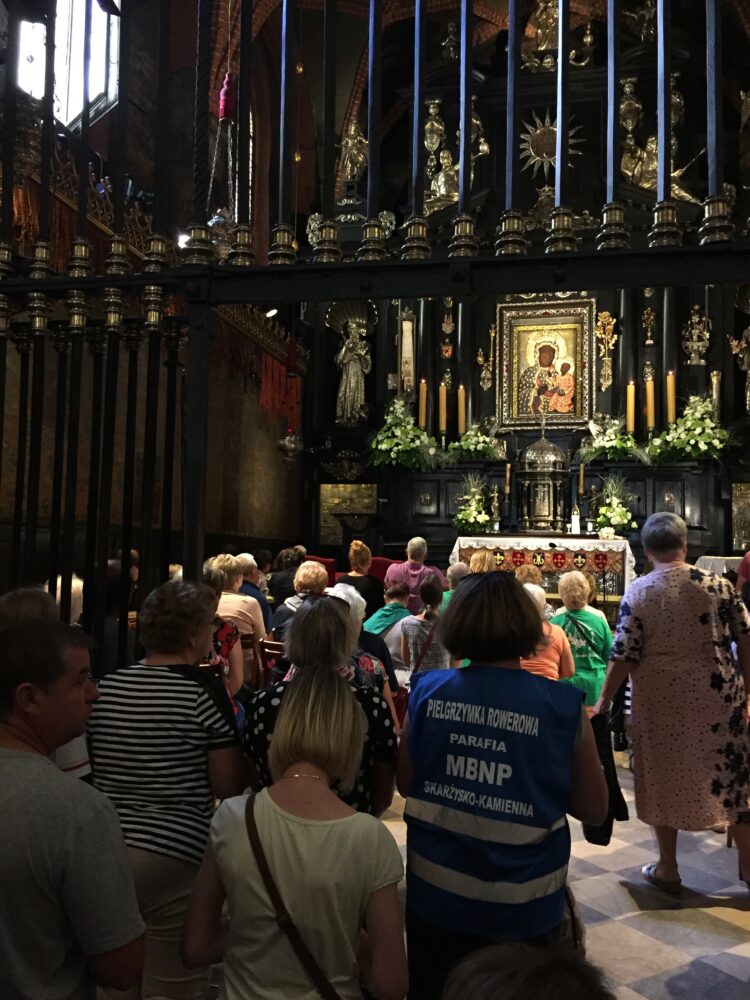
The Black Madonna; the end of the quest (Photo: Chris Newens)
Outside the church, when it is over, I find Lucas, smiling. This is a good moment to explain to him the understanding I have just reached, and in its spirit, I ask him his favourite moment of the pilgrimage.
“Everyone has their own experience walking to Czestochowa,” says the novice priest, ever the diplomat, “but for me, every time I come, the best moment is in the chapel standing in front of the Madonna. I think it has to be, no?”